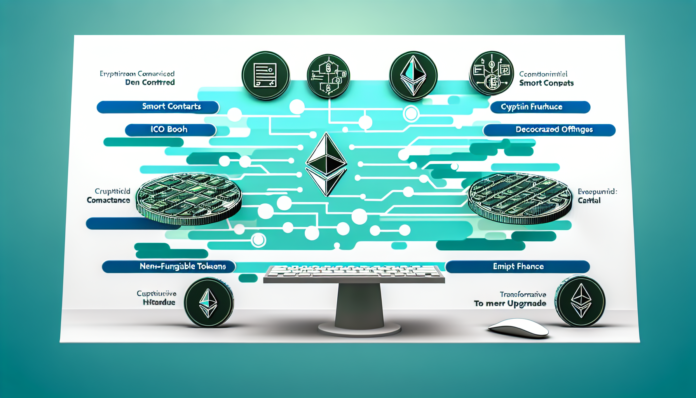Ethereum’s first decade has been a remarkable journey marked by pioneering innovation, turbulent market cycles, and transformative technological upgrades. Since its launch in 2015, Ethereum has evolved from a novel concept into the backbone of the decentralized finance (DeFi) and non-fungible token (NFT) ecosystems, influencing how digital assets and smart contracts are created and used worldwide. Its highs and lows have consistently reflected the broader crypto market’s expressions of excitement, skepticism, and maturity.
The Early Days and the ICO Boom
Ethereum was proposed in late 2013 by Vitalik Buterin as a programmable blockchain platform that went beyond Bitcoin’s capabilities, enabling the creation of smart contracts—self-executing contracts with the terms directly written into code. Officially launching in mid-2015, Ethereum rapidly gained traction as a development environment for decentralized applications (dApps).
One of the earliest and most significant phenomena to highlight Ethereum’s potential was the 2017 ICO (Initial Coin Offering) frenzy. Entrepreneurs and developers leveraged Ethereum’s smart contract infrastructure to raise funds by creating and selling new cryptocurrency tokens, leading to a spectacular rise in the price of Ether (ETH), the native token. The token price soared from under $10 in early 2017 to nearly $800 by year’s end, attracting enormous speculative interest and investment.
However, this explosive growth came with challenges. The surge in transactions from ICOs caused network congestion, making Ethereum slow and expensive to use at times. The CryptoKitties craze, an NFT game where users bred digital cats, famously clogged the Ethereum blockchain in late 2017, revealing early scalability limitations and foreshadowing the need for architectural improvements.
Challenges and Controversies
Ethereum’s journey has also been shaped by significant controversies and difficult technical moments. In 2016, the DAO (Decentralized Autonomous Organization) — a groundbreaking but vulnerable smart contract investment fund — suffered a $50 million theft due to an exploit. To address this, the Ethereum community controversially chose to hard fork the network to reverse the theft, splitting Ethereum into two chains: the main Ethereum chain and Ethereum Classic, which continued the original ledger without changes.
Network congestion, security concerns, and debates around decentralization have consistently challenged Ethereum’s governance and development. Price volatility has mirrored these struggles, including the 2018 crypto market crash where Ether plummeted from nearly $1,400 to below $100. Still, Ethereum’s adaptability and community commitment have helped it recover and innovate through each cycle.
The Rise of DeFi and NFTs
From 2020 onward, Ethereum solidified its position as the foundation of decentralized finance and digital collectibles. The DeFi boom unlocked novel financial instruments on Ethereum — including lending platforms, decentralized exchanges, and algorithmic stablecoins — allowing users worldwide to borrow, lend, and trade without intermediaries. This also drove dramatic increases in Ethereum transaction volume and value locked in DeFi protocols.
Simultaneously, the NFT market exploded in 2021, showcasing Ethereum’s versatility in representing ownership of unique digital assets like art, music, and collectibles on the blockchain. Landmark NFT sales brought mainstream attention to the Ethereum ecosystem, further driving participation and infrastructure development.
The Merge: A Turning Point for Sustainability and Scalability
Ethereum’s technical evolution has reached a critical milestone with the Merge, completed in September 2022. This upgrade replaced Ethereum’s original proof-of-work (PoW) consensus mechanism — which relied on energy-intensive mining — with the far more efficient proof-of-stake (PoS) system. By transitioning to PoS, Ethereum cut its energy consumption by approximately 99.99%, addressing one of the most significant environmental criticisms facing cryptocurrencies.
Beyond energy savings, the Merge decreased Ethereum’s issuance of new ETH tokens, contributing to a reduction in inflationary pressure and enhancing scarcity. The move also laid the groundwork for future scalability solutions like sharding and Layer-2 rollups, which aim to increase transaction throughput and reduce network congestion without compromising security or decentralization.
Scaling Solutions and Layer-2 Innovations
Ethereum’s scalability challenges have been an ongoing bottleneck, but the post-Merge environment has accelerated Layer-2 development. These solutions operate atop the Ethereum mainnet and process transactions more efficiently by bundling or “rollup” techniques, reducing costs and increasing speed.
- Layer-2 Rollups: Technologies like Optimistic Rollups and Zero-Knowledge Rollups aggregate multiple transactions off-chain and post summaries on the main Ethereum chain, significantly boosting throughput.
- Sidechains and State Channels: Complementary approaches help offload transactions or computations, enhancing the user experience and enabling broader dApp adoption.
Collectively, these innovations respond directly to the congestion problems first highlighted during the ICO period and CryptoKitties episode, demonstrating Ethereum’s ongoing adaptability.
The Road Ahead: Institutional Adoption and Regulation
Now entering its second decade, Ethereum faces new opportunities and challenges as crypto matures. The introduction of spot Ethereum ETFs and increased institutional interest suggests growing mainstream acceptance. Regulatory scrutiny is intensifying, which could both clarify the legal framework and impose constraints.
Ethereum continues to balance its foundational principles of decentralization and openness with the demands for scalability, security, and regulatory compliance. Its roadmap includes upcoming upgrades focused on sharding, enhanced privacy, and developer tooling, all aimed at maintaining its position as the leading smart contract platform.
Conclusion
Ethereum’s first ten years have been a blend of spectacular innovation, dramatic volatility, and profound transformations in the crypto landscape. From the ICO craze that introduced tokenized fundraising to the rise of DeFi and NFTs, and from overcoming major technical and governance hurdles to completing the environmentally crucial Merge, Ethereum has repeatedly reshaped what blockchain technology can achieve. As it continues to evolve, Ethereum mirrors the broader crypto ecosystem’s chaotic, creative spirit—showcasing a technology still very much in motion, with the potential to redefine finance, ownership, and digital interaction for years to come.
















